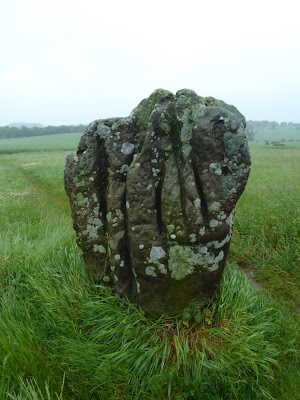Our expedition last weekend was to
Slate Hill, and its not (yet?) excavated, but almost certainly early Iron Age ('Celtic' - probably about 700-500 BC) mini-
hillfort to the north of Bolam Lake. It is the roughly semicircular structure made by little black triangles and labelled 'settlement':
There are remains of an impressive
four concentric rings of mounds surrounding the settlement - which are presumed to have been topped by walls and a palisade. To the south there is a steep cliff, now wooded. This implies a significant need for defence, and therefore a significantly violent, warring kind of society.
Modern methods of excavation often reveal that these Celtic forts (at least in the South of England) were built on top of Neolithic-Bronze Age 'temples'. In Neolithic-Bronze Age times, such hilltops seem to have been non-residential places which people attended for feats and other (presumed) rituals. These usually had a single circular mound and ditch - and some had stone circles. Whether something of the sort lies beneath Slate Hill is not known; probably not.
When the large scale, peaceful Neolithic-Bronze Age society broke down into warring tribes, these temples were sometimes occupied and defended by further ditched, and walls and palisades. Some of these pre-Roman forts were again and further fortified in post-Roman times against the invading Anglo-Saxons. This was the case of the much larger South Cadbury ('Camelot') in Somerset.
However, Slate Hill is a much smaller affair - perhaps the residence of an extended family rather than a clan.
An artist's impression of the place:
The Ancient British Celts seemingly liked to live in
round houses; and even during the Roman occupation this preference continues. This in turn suggests something more than either fashion or functionality - that the roundness of the houses, the internal layout (hearth at the centre) probably has some fundamental religious significance.
It has been suggested that - in this warring, small-scale society - and after the Neolithic-Bronze age 'megalithic;' structures had fallen into disuse (presumably defended from general access, and/or too dangerous to visit); the household may have become the centre of religious practice.
Inside the enclosure there are many lumps and bumps of grassy earth, but nothing we could identify. The whole area, including inside the enclosure, has multiple conical depressions about 20 feet across - these are the remains of slate mines from the past few hundred years (which gave the hill its name). No doubt these will have destroyed a fair bit of the Iron Age structure, but they have certainly made for an appealingly intricate landscape.
The site commands a delightful view to the North - including a further, larger, nearby defended enclosure which we hope to visit soon. This is indeed part of a larger multi-site landscape of ancient features, including
three other hillforts.


























